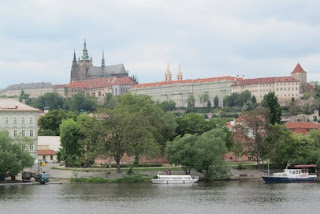He became famous almost overnight, when he was the only artist available over the Christmas holidays to design a new poster for the last minute demands of the French actress, Sarah Bernhardt. With less than two weeks to work, he innovated. Speculation is that because he had to work so quickly, he had to rely on training and instinct. Even so, he was successful in large part because he broke the rules successfully.
First, he made the poster tall and thin, using two of the standard printing stones together. Second, he used his trademark flowing style that became known as Art Nouveau. Third, although he tried the bright colors typical of posters of the time, such as those by Toulouse-Lautrec, during the trial printings he prefered the pastel, faded images of later prints, so he adopted that color pallette. Sarah Bernhardt signed a six-year contract with him to do posters, costumes and props, and he became a sensation for advertising and all sorts of household items. He was committed to bringing art to the masses via these mundane objects.
I collected a book of posters and some playing cards with images to study. I want to look for his Documents Decoratifs book that was a student primer for abstracting from nature and design.After putting Joren through an art lesson, we went to a second museum of more interest to him, the Museum of Communism, detailing the history of the rise and fall of Communism in the Czech Republic. I can't say that I knew muczh about Czech history, tending to lump anything to do with Communism in with the Soviet Republic. We saw photos of the invasion of Prague by Nazi tanks during WW II. In 1948, Communist officials took over the elected government, supposedly with a more liberal agenda, but that soon gave way to the strict Soviet approach, eventually with Russian tanks for enforcement. The propaganda shown in the museum was rather too familiar, with a fear-based appeal to the uneducated. After many years of decreasing economic stability, in 1989 repeated protests in Weneslas Square led to the peaceful restoration of Democracy, known as the Velvet Revolution.
After a late lunch of pasta (carbonara and pesto) on Old Town Square, we finally strolled over the river via the Charles Bridge, dating from the 14th century. Lined with statues, street artists and performers, it provided a great view up the hill toward Prague Castle.
After crossing into Mala Strana (Lesser Quarter), we viewed the Church of St. Nicholas, with its green towers that we photographed the previous day from the castle. Then we found the Valstejnska Zahreda (Wellenstein Palace Gardens) through a nondescript door in a wall. Inside, we enjoyed searching for figures in the "grotto," an artificial dripstone wall that had puzzled us from the ramparts above yesterday.We also solved the mysterious birdcall question when we spotted the white peacock that lives here.

Soon, our feet gave out and we returned to the hotel for the evening and a reasonable bedtime, after blogging.








No comments:
Post a Comment